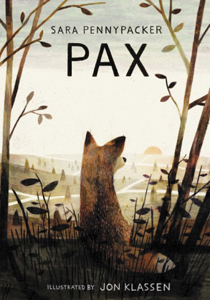Spring 2016 Publishers' Preview: Five Questions for Sara Pennypacker
This interview originally appeared in the March/April 2016 Horn Book Magazine as part of the Spring Publishers’ Preview, a semiannual advertising supplement that allows participating publishers a chance to each highlight a book from its current list. They choose the books; we ask the questions.
Sponsored by
![]()
In Sara Pennypacker’s Pax, Peter’s father enlists, sending Peter to his grandfather’s house and the boy’s pet fox, Pax, to the wilderness. Peter, though, resolves to go back home and find him.
 Photo: Lorraine Scheppler.
Photo: Lorraine Scheppler.
1. Do you know more about that war in the background than you are letting on?
SP: No. I never even wanted to imagine any details — I wanted the background to be War in General so the reader couldn’t distance him or herself by saying, “Oh, that didn’t happen here.” But I fear that our nation is as polarized as it has been since the Civil War and therefore at risk to repeat it — I guess that’s something about the background I’m not letting on.
2. How did you decide how much anthropomorphism to use?
SP: Early on, the book was allegorical, and I assumed I would completely anthropomorphize the animal characters. But the more I learned about foxes, the more respectful of them I became, and that respect led me to render them as naturalistically as possible.
 3. Shades of “Hansel and Gretel,” or is that just me?
3. Shades of “Hansel and Gretel,” or is that just me?
SP: “Hansel and Gretel” haunted me when I was little — the betrayal! — so maybe subconsciously I was working something out. But writing the opening chapter, I was exploring something else: the agony we feel when we can’t communicate with someone we love. If he could have, Peter would have explained his actions to Pax, giving him comfort and guidance.
4. Do you think Pax is a “boy book”?
SP: Aarrgghh, I hate the fact that “boy book” and “girl book” are still even terms, but that’s a discussion for another time. So…here’s what happened: between the Clementine series and my previous novel, Summer of the Gypsy Moths, I realized I hadn’t written a male main character in a decade, so I made both Peter and Pax males to challenge myself. And I patterned Pax on a classic Hero’s Journey, which is arguably a male structure, so, yes, I guess “boy book” is a fair tag. But again, aarrgghh…
5. And, oh, that ending. Did you always know it was coming?
SP: No. It came to me about halfway through writing the book, which took five years, and it was the point at which I finally knew I was telling the right story. What I didn’t know until the very last draft was from whose point of view that ending would be related. I chose Peter’s because, when seen through Pax’s POV, the ending was too painful for me.
Sponsored by
![]()
RELATED
ALREADY A SUBSCRIBER? LOG IN
We are currently offering this content for free. Sign up now to activate your personal profile, where you can save articles for future viewing.







Add Comment :-
Be the first reader to comment.
Comment Policy:
Comment should not be empty !!!